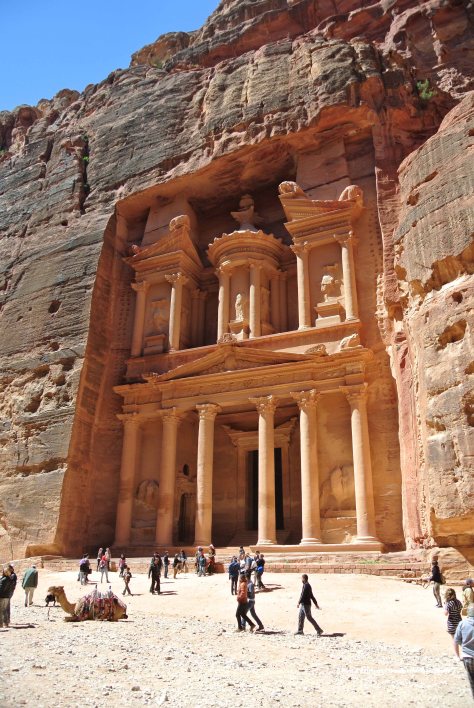
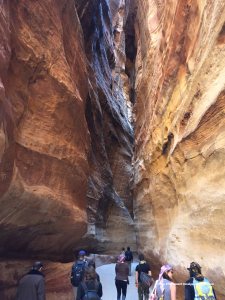
Petra was carved into multi colored mineral laden sandstone by the Nabataeans c. 300 B.C., yet this geographically strategic region in present day Jordan generated wealth for whoever had control long before the city existed. As a center for long-haul caravans, some stretching for 700 camels, Petra was an ideal junction for the distribution of goods on their way south, west and north into the Levant, Egypt and the Eastern Mediterranean. As for security, Petra was a natural bank vault.
The massive city was carved into the red sandstone cliffs on the flanks of Jordan’s vast dry Wadi Araba. The dramatic main entrance through a long towering and narrow gorge – a Siq – was a defensive and psychological tour de force. The eyes are focused on the first building that comes into view, the impressive Al Khaznch. Popularly known as the Treasury, its purpose was more likely ceremonial – shock and awe.

Named a UNESCO World Heritage Site in 1985, chosen in 2007 as one of the New 7 Wonders of the World and discovered by Hollywood in the Indiana Jones franchise, Petra deserves its reputation as the top tourist attraction in the Hashemite Kingdom of Jordan. With an international mix of visitors, the carriage, horse, donkey and camel rides, the craft and trinket stalls, local musicians and water hawkers add a visceral caravan atmosphere to a serious archaeological site.

Petra’s dominance of the Spice Route in the Levant continued well into the Roman era when the city became the capital of the empire’s Arabian province. Although it’s not clear what use the Nabataeans meant for many structures, the Romans added obvious flourishes – an impressive theater, colonnaded market and freestanding temples. Yet if it were not for the genius of three human accomplishments, the glory of Petra would have been impossible.

Petra’s wealth and life in the Cradle of Civilization were based on wheat, sheep and water. The domestication of a wild grain and a feisty animal in prior millenniums allowed for settled life and the rise of towns. Yet all life was dependent on water, especially in regions prone to drought. The Nabataeans mastered an efficient system of dams, cisterns and water channels carved in rock that provided this desert city with a profitable surplus of water.

While Petra declined after the 5th century A.D. due to changing commercial routes and serious earthquakes, wheat, sheep, people and the need for water remained. The cuisine of Jordan’s Bedouin culture harken back to the basics of ancient settled life. Flat ash bread is still buried under the hot coals while goat, lamb and poultry may be grilled or baked in a hot sand pit. Vegetables of all types are pickled and dried fruits, nuts and cheese round out the basics.

Who knows when humans first discovered that slathering toppings on flat rounds of bread and baking them were tasty and had infinite possibilities? Among the many dozens of mezze – small plates – that dominate Jordanian cuisine, Araies Iahma is a favorite among locals and visitors. Known as Bedouin Pizza, araies lahma is easy to prepare.

Araies Iahma (Bedouin Pizza) – 8 servings
Ingredients:
- 1 pound ground meat – any combination of lamb, beef, mutton or goat
- 1 medium onion, diced
- ½ cup olive oil
- 1 green chili pepper, seeds removed, diced
- 2 cloves garlic, crushed and diced
- 2 tomatoes, blanched, skinned and diced (see preparation)
- 1 teaspoon ground cumin
- 1 teaspoon sea salt
- pita bread

Preparation:
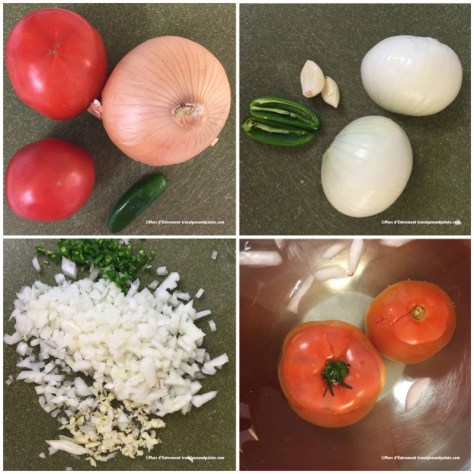
- Preheat oven to 350°F (180°C)
- Blanch the tomatoes for 45 seconds in boiling water and plunge into a bowl of ice water. Using a sharp knife slit the sides of the skin and slip off the skin
- Finely dice the tomatoes, onion, chili pepper and garlic
- Add the salt, cumin, and diced vegetables to the ground meat and mix well.
- Cut each round of pita in half, and spread a thin layer of meat inside each pocket.
- Brush the stuffed pita halves with olive oil and arrange on a sheet pan.
- Bake for 7 minutes, turn each pita over and continue for 5 minutes more.
Serve hot with a salad as a light lunch, as an appetizer or part of a festive and elaborate Jordanian mezze buffet.

Araies Iahma is just one of a dozen dishes a visitor can participate in preparing at the Petra Kitchen. The staff of the Petra Kitchen under manager Ali and chef Mustafe have created a participatory dinner that introduces guests to the top tastes of Jordanian cuisine. Couple this with its location at the very epicenter of ancient human achievement, and dining in Petra becomes a bonding experience with the ancestors.
When you go:
Non-stop flights are available from major North American hubs to Amman, Jordan.
Petra is a 3-hour drive south from Amman on modern highways. Although day excursions can easily be arranged from Amman, to give Petra its due, an overnight in one of the new town’s attractive hotels is recommended.
As in all hot arid regions, visitors to Petra are urged to carry and drink plenty of water. Visiting the entire site entails walking 6 to 9 miles round trip, but carriage, horse, donkey and camel transportation is available. Bottled water is easily purchased in the historic site from numerous vendors.
A nighttime candle light illumination of the Al Khaznch (the Treasury) is not recommended. Candlelight at its base fails to do the vast edifice justice. Save your energy for the daylight.

Disclaimer: the author was a guest of the Jordan Tourism Board North America, the Moevenpick Petra Hotel and the Petra Kitchen. Araies Iahma recipe reproduced courtesy of the Petra Kitchen.
You can read additional articles on Jordan by Marc d’Entremont at:
The historic beauty of Jordan
Four serene destinations in timeless Jordan
Not all Jordan almonds are Jordan Almonds
A glimpse at the Hashemite Kingdom of Jordan
You can read more articles by Marc d’Entremont at:
Hellenic News of America
Original World Insights

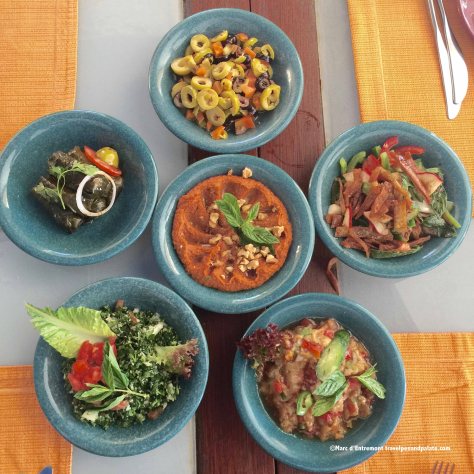





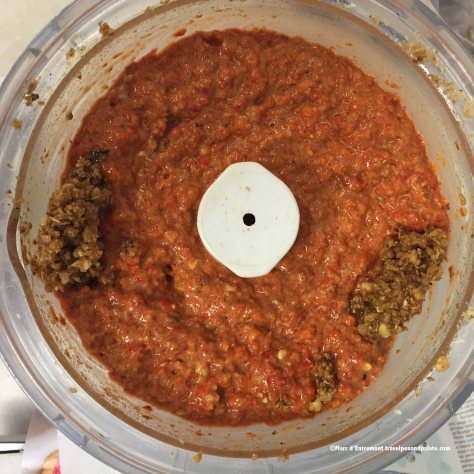


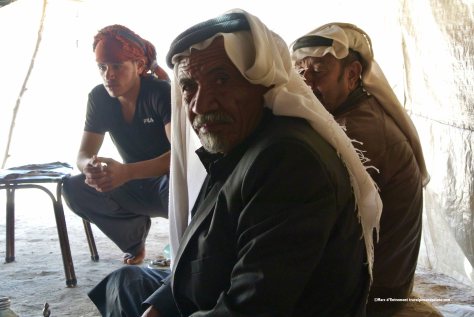





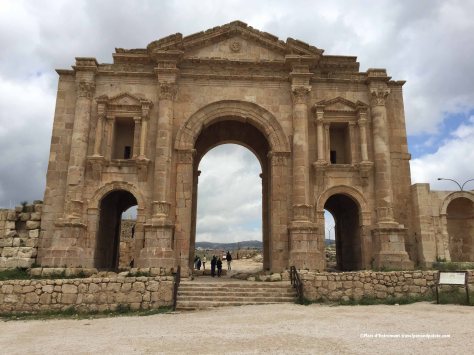









You must be logged in to post a comment.